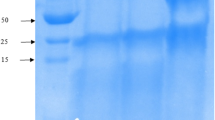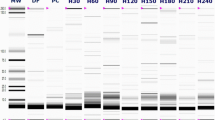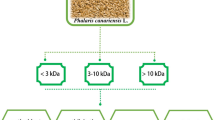Abstract
Canary seed (Phalaris canariensis) is used to feed birds but it has been recently considered a promising cereal with nutraceutical potential for humans. The aim of this work was to analyze the protein fractions from canary seed flour and from milk substitutes (prepared by soaking the seeds in water 12 and 24 h), and to evaluate antioxidant and antihypertensive capacity of peptides obtained after in vitro digestion. Prolamins were the major protein fraction, followed by glutelins. After digestion, albumins and prolamins fractions from milks presented higher levels of peptides than flour, globulins showed more peptides in flour and glutelins were found in similar concentrations in all samples; 24 h milk prolamins had the highest concentration of peptides. Purification by high performance liquid chromatography (HPLC), sequencing of peptides, in vitro antioxidant ABTS (2,2′-azino-bis, 3-ethylbenzothiazoline-6-sulphonic acid) and DPPH (2,2-diphenyl-1-picrylhydrazyl) assays, and antihypertensive capacity (angiotensin converting enzyme (ACE) assay), indicated that peptides from canary seed prolamins were the most efficient compounds with antioxidant and antihypertensive activity. Canary seeds may be considered an accessible and cheap source to prepare milk substitutes with high contents of bioactive peptides with remarkable functional properties to promote better human health and healthy ageing.


Similar content being viewed by others
References
Cogliatti M (2012) Canary seed crop. Sci Agric 1:75–88
Robinson RG (1978) Chemical composition and potential uses of annual canary grass. Agron J 70:797–800
Robinson RG (1979) Annual canary grass: a potential food grain crop. Crops Soil 32:13–15
Abdel-Aal ESM, Hucl P, Sosulski FW (1997) Structural and compositional characteristics of canary seed (Phalaris canariensis L.). J Agric Food Chem 45:3049–3055
Abdel-Aal ESM, Hucl P, Miller SS, Patterson CA, Gray D (2011a) Microstructure and nutrient composition of hairless canary seed and its potential as a blending flour for food use. Food Chem 125:410–416
Abdel-Aal ESM, Hucl P, Patterson CA, Gray D (2011b)Phytochemicals and heavy metals content of hairless canary seed: a variety developed for food use. LWT-Food Sci Technol 44:904–910
Putnam DH, Oelke EA, Oplinger ES, Doll JD, Peters JB (1990) Annual canary grass. University of Wisconsin, Retrieved November 15, 2014 from: "http://www.hort.purdue.edu/newcrop/afcm/cangras.html"
Putnam DH, Miller PR, Hucl P (1996) Potential for production and utilization of annual canary grass. Cereal Foods World 41:75–83
Estrada-Salas PA, Montero-Morán GM, Martínez-Cuevas PP, González C, Barba de la Rosa AP (2014) Characterization of antidiabetic and antihypertensive properties of canary seed (Phalaris canariensis L.) peptides. J Agric Food Chem 62:427–433
Boye JI, Achouri A, Raymond N, Cleroux C, Weber D, Koerner TB, Hucl P, Patterson CA (2013) Analysis of glabrous canary seeds by ELISA, mass spectrometry, and western blotting for the absence of cross-reactivity with major plant food allergens. J Agric Food Chem 61:6102–6112
Magnuson BA, Patterson CA, Hucl P, Newkirk RW, Ram JI, Classen HL (2014) Safety assessment of consumption of glabrous canary seed (Phalaris canariensis L.) in rats. Food Chem Toxicol 63:91–103
Novas MJ, Jiménez AM, Asuero AG (2004) Determination of antioxidant activity of canary seed infusions by chemiluminescence. J Anal Chem 59:84–86
Pérez-Gutiérrez RM, Madrigales AD, Horcacitas MDC, García-Baez E, Cruz-Victoria T, Mota-Flores JM (2014) Ameliorativeeffect of hexane extract of Phalaris canariensis on high fat diet-induced obese and streptozotocin-induced diabetic mice. Evid Based Complement Alternat Med 2014:145901. doi:10.1155/2014/145901.
Passos CS, Carvalho LN, Pontes RB, Campos RR, Ikuta O, Boim AM (2012) Blood pressure reducing effects of P. canariensis in normotensive and spontaneously hypertensive rats. Can J Physiol Pharmacol 90:201–208
Inkanatural (2014) Canary seed: properties and contraindications. Retrieved November, 2014 from: "http://www.inkanatural.com/en/arti.asp?refcanary-seed-en/
Sandoval-Oliveros R, Paredes-López O (2013) Isolation and characterization of proteins from chia seeds (Salvia hispanica L.). J Agric Food Chem 61:193–201
Wang W, Bringe NA, Berhow MA, González de Mejía E (2008) B-conglycinins among sources of bioactive in hydrolysates of different soybean varieties that inhibit leukemia cells in vitro. J Agric Food Chem 56:4012–4020
Luna-Suárez S, Medina-Godoy S, Cruz-Hernández A, Paredes-López O (2010) Modification of the amaranth 11S globulin storage protein to produce an inhibitory peptide of the angiotensin converting enzyme, and its expression in Escherichia coli. J Biotechnol 148:240–247
Orona-Tamayo D, Valverde ME, Nieto-Rendón B, Paredes-López O (2015) Inhibitory activity of chia (Salvia hispanica L.) protein fractions against angiotensin I-converting enzyme and antioxidant capacity. LWT-Food Sci Technol 64:236–242
Zhou H, Chen X, Wang C, Ye J, Chen H (2012) Purification and characterization of a novel ~18 kDa antioxidant protein from Ginkgo biloba seeds. Molecules 17:14778–14794
Martínez-Cruz O, Paredes-López O (2014) Phytochemical profile and nutraceutical potential of chia seeds (Salvia hispanica L.) by ultra high performance liquid chromatography. J Chrom A 1346:43–48
Orsini-Delgado MC, Galleano M, Añón C (2015) Amaranth peptides from simulated gastrointestinal digestion: antioxidant activity against reactive species. Plant Foods Hum Nutr 70:27–34
Meneses EP, Villa-Hernández O, Hernández-Orihuela L, Castro-Franco R, Pando V, Aguilar MB, Batista CVF (2011) Peptidomic analysis of the skin secretions of the frog Pachymedusa dacnicolor. Amino Acids 40:113–122
Minkiewicz P, Dziuba J, Iwaniak A, Dziuba M, Darewicz M (2008)BIOPEP database and other programs for processing bioactive peptide sequences. J AOAC Int 91:965–980
Holding R (2014) Recent advances in the study of prolamin storage protein organization and function. Front Plant Sci 5:1–9
Rajamohamed SH, Aryee ANA, Hucl P, Patterson CA, Boye JI (2013) In vitro gastrointestinal digestion of canary seed proteins as affected by variety and thermal treatment. Plant Foods Hum Nutr 68:306–312
Huang WY, Davidge ST, Wu J (2013) Bioactive natural constituents from food sources-potential use in hypertension prevention and treatment. Crit Rev Food Sci Nutr 53:615–630
Velarde-Salcedo AJ, Barrera-Pacheco A, Lara-González S,Montero-Morán GM, Díaz-Gois A, González de Mejia E, Barba de la Rosa AP (2013) In vitro inhibition of dipeptidyl peptidase IV by peptides derived from the hydrolysis of amaranth (Amaranthus hypochondriacus L.) proteins. Food Chem 136:758–764
Montoya-Rodríguez A, Gómez-Favela MA, Reyes-Moreno C, Milán-Carrillo J, González de Mejía E (2015) Identification of bioactive peptide sequences from amaranth (Amaranthus hypochondriacus) seed proteins and their potential role in the prevention of chronic diseases. Compr Rev Food Sci Food Saf 14:139–158
Capriotti AL, Caruso G, Cavaliere C, Samperi R, Ventura S, Chiozzi RZ, Laganà A (2015) Identification of potential bioactive peptides generated by simulated gastrointestinal digestion of soybean seeds and soy milk proteins. J Food Compos Anal 44:205–213
Acknowledgments
We acknowledge partial support from Consejo Nacional de Ciencia y Tecnología, México to carry out this study. The authors wish to thank Talía Hernández Pérez for technical assistance, CINVESTAV-Irapuato, México.
Author information
Authors and Affiliations
Corresponding author
Ethics declarations
Conflict of Interest
The authors declare no conflict of interest. This article does not contain any studies with human or animals subjects.
Electronic supplementary material
ESM 1
(PDF 212 kb)
Rights and permissions
About this article
Cite this article
Valverde, M.E., Orona-Tamayo, D., Nieto-Rendón, B. et al. Antioxidant and Antihypertensive Potential of Protein Fractions from Flour and Milk Substitutes from Canary Seeds (Phalaris canariensis L.). Plant Foods Hum Nutr 72, 20–25 (2017). https://doi.org/10.1007/s11130-016-0584-z
Published:
Issue Date:
DOI: https://doi.org/10.1007/s11130-016-0584-z




